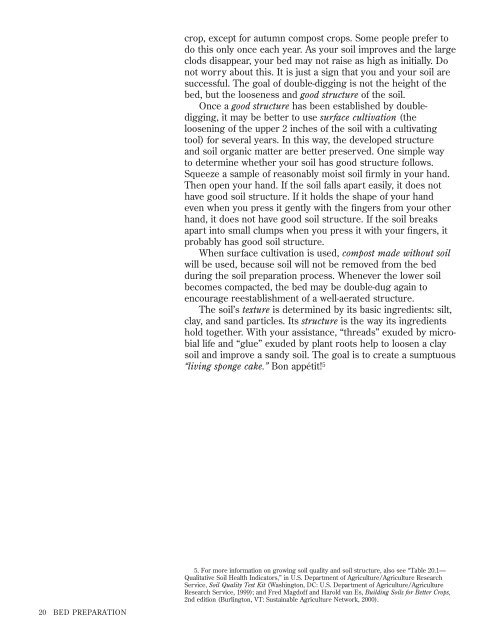How to Grow More Vegetables : And Fruits, Nuts ... - Shroomery
How to Grow More Vegetables : And Fruits, Nuts ... - Shroomery
How to Grow More Vegetables : And Fruits, Nuts ... - Shroomery
You also want an ePaper? Increase the reach of your titles
YUMPU automatically turns print PDFs into web optimized ePapers that Google loves.
20 BED PREPARATION<br />
crop, except for autumn compost crops. Some people prefer <strong>to</strong><br />
do this only once each year. As your soil improves and the large<br />
clods disappear, your bed may not raise as high as initially. Do<br />
not worry about this. It is just a sign that you and your soil are<br />
successful. The goal of double-digging is not the height of the<br />
bed, but the looseness and good structure of the soil.<br />
Once a good structure has been established by doubledigging,<br />
it may be better <strong>to</strong> use surface cultivation (the<br />
loosening of the upper 2 inches of the soil with a cultivating<br />
<strong>to</strong>ol) for several years. In this way, the developed structure<br />
and soil organic matter are better preserved. One simple way<br />
<strong>to</strong> determine whether your soil has good structure follows.<br />
Squeeze a sample of reasonably moist soil firmly in your hand.<br />
Then open your hand. If the soil falls apart easily, it does not<br />
have good soil structure. If it holds the shape of your hand<br />
even when you press it gently with the fingers from your other<br />
hand, it does not have good soil structure. If the soil breaks<br />
apart in<strong>to</strong> small clumps when you press it with your fingers, it<br />
probably has good soil structure.<br />
When surface cultivation is used, compost made without soil<br />
will be used, because soil will not be removed from the bed<br />
during the soil preparation process. Whenever the lower soil<br />
becomes compacted, the bed may be double-dug again <strong>to</strong><br />
encourage reestablishment of a well-aerated structure.<br />
The soil’s texture is determined by its basic ingredients: silt,<br />
clay, and sand particles. Its structure is the way its ingredients<br />
hold <strong>to</strong>gether. With your assistance, “threads” exuded by microbial<br />
life and “glue” exuded by plant roots help <strong>to</strong> loosen a clay<br />
soil and improve a sandy soil. The goal is <strong>to</strong> create a sumptuous<br />
“living sponge cake.” Bon appétit! 5<br />
5. For more information on growing soil quality and soil structure, also see “Table 20.1—<br />
Qualitative Soil Health Indica<strong>to</strong>rs,” in U.S. Department of Agriculture/Agriculture Research<br />
Service, Soil Quality Test Kit (Washing<strong>to</strong>n, DC: U.S. Department of Agriculture/Agriculture<br />
Research Service, 1999); and Fred Magdoff and Harold van Es, Building Soils for Better Crops,<br />
2nd edition (Burling<strong>to</strong>n, VT: Sustainable Agriculture Network, 2000).












